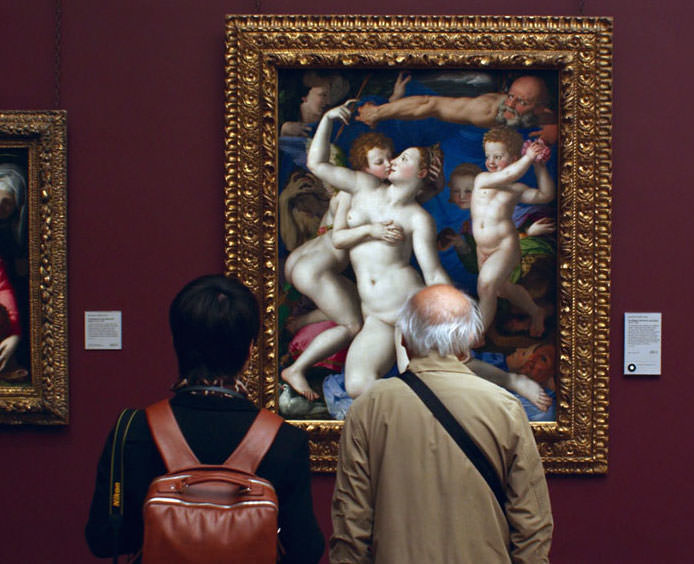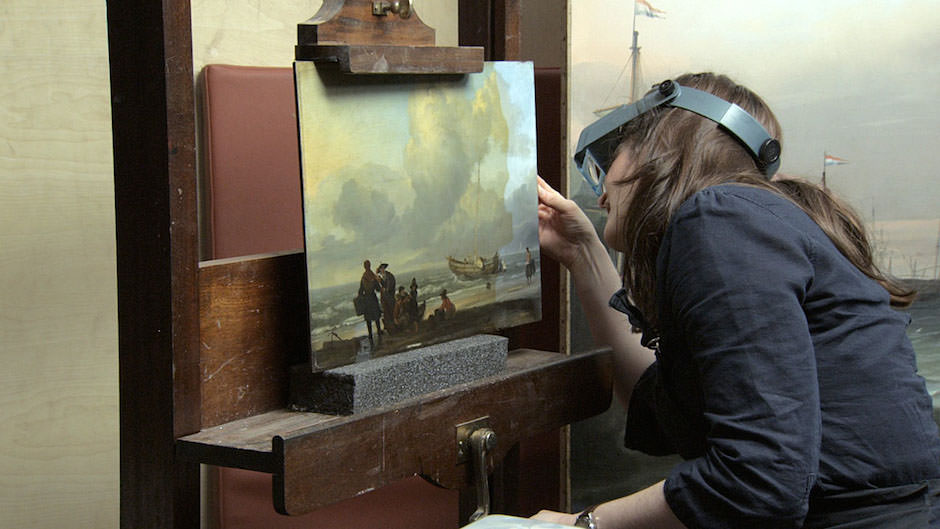Oh, how people suffer for art—not the artists, but those who wait for hours to see the great blockbuster exhibitions. At the heart of Frederick Wiseman’s brilliant three-hour documentary on the National Gallery in London is the 2012 exhibition, Leonardo da Vinci: Painter at the Court of Milan, the highlight of Nicholas Penny’s six years as director. Slowly, the camera pans along the long line of people waiting patiently in the rain. It is cold, they are wrapped in coats, blankets, sleeping bags. They warm their hands on mugs of coffee, make phone calls, sigh, hug each other to fend off the chill. Once inside the packed rooms, they move as if in a dream. Everywhere there are faces: young, old, lined, bland, curious, rapt, moved. Above their heads float other faces, like the Lady with the Ermine serene and mysterious, gazing down on her admirers. At times, watching the film feels like being underwater, or in an aquarium sealed off from the world—but which are the fish, and who is looking at whom?
Wiseman is now eighty-four, and this documentary is made with all the sympathy and sly craft that have distinguished his work over the years. It flows and shifts like water through its three hours, so smoothly that time seems to vanish. He makes us feel both one of the crowd and a privileged insider. As the rooms empty, curators explain the knowledge of Leonardo’s technique that the show has brought them, pondering the value of seeing the pictures together and Leonardo’s extraordinary capacity to “paint the invisible,” the just-out-of-reach—a spiritual quality that speaks across time.
At points like this Wiseman’s own audience become students. The curators and lecturers, like the rest of the Gallery’s staff, remain nameless, and it seems right to follow his lead, but we get to know the speakers as we watch lectures and classes of different kinds. And although in passing we may learn about Caravaggio, Rembrandt, or Vermeer, about Holbein and Henry VIII, about the ethos of the Counter-Reformation or Titian’s use of poesia, we learn almost more about the varied ways that art can be brought to life today. Here are a bunch of schoolchildren, encouraged to find stories in the pictures around them. In total contrast, a smartly dressed group of middle-aged adults—are they patrons, or Friends?—listen to Penny explaining Poussin’s sophisticated “sculptural” approach in the Triumph of Pan, as having arisen from his knowledge that his work would be hung alongside a Mantegna. Elsewhere amused visitors are asked to imagine themselves as spies ordered to befriend and seduce a target, so that they can see the tender, painful ambiguity of betrayal in Rubens’s Samson and Delilah.
In front of a medieval altarpiece, the same lecturer invites her group to pretend they are in a dark church, where candles flicker off the vestments of the saints so that they seem to move, persuading the illiterate that they can intercede for them in heaven. Wiseman’s film constantly examines light and its effects, in the gallery at dusk, in his close-ups of paintings by Turner and Claude, lingering on distance and detail, on sunlight and reflections, on silhouettes against glimmering canvases. A specific point about light—and about the multiple ways of “looking” at a work—emerges from a separate discussion of Ruben’s Samson, where we learn that the huge painting originally hung high above a fireplace, with a window on the left, so that Rubens “naturally” lit the painting from that side, with its flickering candle evoking the breeze through the casement. “And see here,” says the curator, pointing to the inside of Samson’s bent knee, where Rubens knew it would be in shadow, “he’s just done zig-zags—he hasn’t bothered to do any real modelling at all.”
But artists sometimes used colored varnish to create such shadows. When restorers strip all this off, might paintings lose their original effects? Wiseman leaves this, as he does each scene, without comment. Instead he takes us into the back-rooms with the conservators, restorers and scientists. The work on the frames is my favorite behind-the-scenes revelation. As the leading expert takes a chisel from his neatly lined-up tools, the tools themselves become noisy, knocking, sliding, chipping. Later we learn why an ebony frame on a Rembrandt self-portrait has a particular decoration. The wood is so hard that the metal scraper makes the wood vibrate, causing a ripple effect. This “just happens.” In this marvelous film, even a frame, like the painting it embraces, has its own inner life.
In the restoration studio, a woman works in silence, the sound amplified so that we hear the clink of a cap on a jar or the susurration of a brush as she removes the dusky varnish from a seascape. A senior conservator explains with passion exactly how an x-ray revealed that Rembrandt started his Portrait of Frederick Rihel on Horseback with one painting and then turned the whole canvas sideways and worked directly on top. We admire the conservator’s care and knowledge. But late in the film, Wiseman inserts a startling scene where the same man is “touching in” a shadow on Velázquez’s Christ in the House of Mary and Martha. Is this going too far? No, he argues, we must not treat a work like an archaeological artifact but as “a document you can read.” His duty is to make the artist’s intention clear. Hastily a colleague points out that the touching-up is done on top of the varnish, the principle being that “anything we do,” even months and years of work, “should be reversible.”
Advertisement
Other arguments and discussions, interpretive and technical, financial and political, swell below the surface as the crowds come and go under the gaze of the great paintings. One telling scene shows Nicholas Penny leaning further and further back as an eager marketing woman harangues him about the museum’s need to be more inclusive, less elitist, more alert to the demands of the public. At other moments, museum officials in a budget meeting confront tough Arts Council cuts, or a tense group of staff argue over the virtue of the London Marathon ending outside: is this good publicity, or exploitation by “Sport Relief”? (Uttered in disdain.)
As I write, the National Gallery is facing a different, major, decision. Nicholas Penny will resign in 2015 and his successor has yet to be appointed. Names are flying—among those bandied about are Luke Syson, the head of the European Sculpture and Decorative Arts department at the Met in New York, who curated the Leonardo exhibition during his time at the National Gallery; Gabriele Finaldi, deputy-director of the Prado; and three gallery directors from Holland: Axel Ruger of the Van Gogh Museum, Emilie Gordenker from the Mauritshuis in the Hague, and Taco Dibbits of the Rijksmuseum. The gallery’s press office remains tight-lipped, issuing a wonderfully dead-pan statement simply saying that the trustees are searching for a new director, that Nicholas Penny will stay in his post for the entire recruitment process “in order to affect a smooth handover to his successor,” and “We would never comment on the identity of individual candidates.”
The National Gallery, like an aristocratic grande dame, rarely loses its balance or dignity. In a sudden shift in tone almost exactly half-way through the documentary, Greenpeace activists are shown scaling the roof and unfurling a banner proclaiming “This is not an Oil Painting,” to protest Shell’s plans to drill in the Arctic. There are crowds and shouted swear-words and police cordons in the night. Next day the banner is gone. Dawn breaks on the monumental facade. And inside, we know, the daily work will go on. A cleaner will be polishing the floor. A woman may be blowing slivers of gold foil onto an elaborate frame. Lights will be adjusted, floor plans arranged, wall-coverings torn down between one show and the next—or between one director and the star who will take his place.
Frederick Wiseman’s National Gallery is now showing at many theaters in the United States



